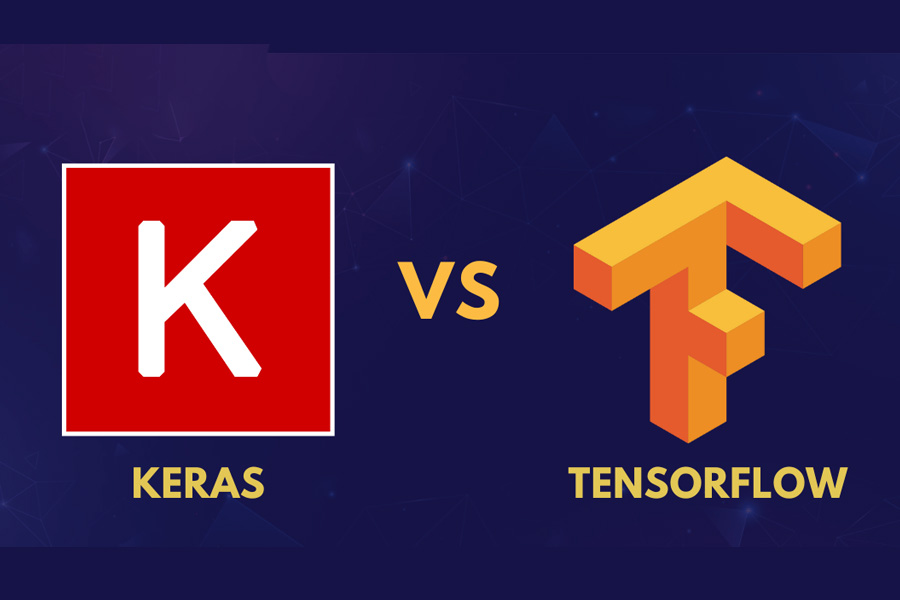The construction and efficacy of machine learning models is greatly impacted by choosing the right deep learning framework. Every framework is unique and has benefits and drawbacks, thus it may be used for different kinds of projects depending on the needs and preferences of the user. We want to help you make an educated decision in the “keras vs. tensorflow” debate by comparing the features, usefulness, and efficiency of these frameworks. In the end, you could select the one that best suits your particular needs.
How Does Deep Learning Work?
Neural networks having numerous layers are used in deep learning, a type of machine learning, to analyze and comprehend complicated data. By mimicking how the human brain works, it makes it easier to automatically extract high-level characteristics from raw data. This approach is effective for picture and audio recognition, autonomous systems, and natural language processing. Two examples of deep learning models that have greatly expanded AI capabilities are convolutional neural networks (CNNs) and recurrent neural networks (RNNs). These models are now essential tools in modern artificial intelligence.
TensorFlow Overview:
Another formidable force in the field of AI and deep learning is TensorFlow. The main reason it is the most well-known deep learning framework is that the Google Brain team developed it. The fact that both Keras and TensorFlow are open-source libraries raises questions such as “Is Keras the same as TensorFlow?
TensorFlow is a library designed specifically for numerical computing problems involving data flow graphs. TensorFlow uses nodes to describe mathematical operations, which makes it easier to do calculations on GPUs, CPUs, and distributed systems. TensorFlow’s edges stand in for data flow channels.
How it helps in ML and Deep Machine Learning:
Several ML and deep learning models may be created with the aid of TensorFlow. It facilitates the development of various supervised and unsupervised learning methods by deep learning researchers. TensorFlow may be used by developers with a variety of programming languages, including Python, Java, and C++. TensorFlow’s main goal is to train machine learning models on big datasets so they can make choices more quickly. TensorFlow has become a reliable tool for applications like word embeddings, recurrent neural networks, image recognition, and natural language processing.
Functionality:
TensorFlow provides a comprehensive range of machine learning features, including as low-level operations, automated differentiation, optimization, and deployment tools, making it more than just a deep learning library.
APIs: Both low-level and high-level APIs are provided by TensorFlow, enabling more straightforward model building as well as fine-grained control over model design and training.
Ecosystem:
TensorFlow has a large and developed ecosystem that includes TensorFlow.js for browser-based applications, TensorFlow Lite for mobile and embedded devices, and TensorFlow Extended (TFX) for production deployment, among other tools.
Graph-Based Execution: TensorFlow has historically been executed using a static computation graph. Eager execution is enabled by default in TensorFlow 2.0 and beyond, enabling dynamic computation without requiring graph creation.
| S.No | TensorFlow | Keras |
| 1. | Tensorhigh-performanceFlow is written in C++, CUDA, Python. | Keras is written in Python. |
| 2. | TensorFlow is used for large datasets and high performance models. | Keras is usually used for small datasets. |
| 3. | TensorFlow is a framework that offers both high and low-level APIs. | Keras is a high-Level API. |
| 4. | TensorFlow is used for high-performance models. | Keras is used for low-performance models. |
| 5. | In TensorFlow performing debugging leads to complexities. | In Keras framework, there is only minimal requirement for debugging the simple networks. |
| 6. | TensorFlow has a complex architecture and not easy to use. | Keras has a simple architecture and easy to use. |
| 7. | TensorFlow was developed by the Google Brain team. | Keras was developed by François Chollet while he was working on the part of the research effort of project ONEIROS. |
An Overview of Keras:
Francois Chollet, a Google developer, developed the open-source, high-level neural network library known as Keras. Enhancing deep learning’s accessibility was the main goal behind the creation of Keras. The distinction between Keras and TensorFlow is evident in the fact that using Keras to construct neural networks does not require coding knowledge.
It provides a high-level API that can aid in the abstraction of deep learning’s related difficulties. Additionally, Keras provides pre-build layers, optimizers, and activation functions so you can concentrate on model creation instead of technical details. Because Python was used in the development of Keras, Python programmers will find it easier to understand its features.
Ease of Use:
Prior to comparing TensorFlow with Keras, it is important to note that Keras is distinguished by its ease of use and versatility. With the ability to analyze the performance of various designs while adjusting hyperparameters, it facilitates the exploration of model concepts and speeds up prototyping. Speech recognition, computer vision, and natural language processing have all advanced thanks in large part to Keras.
Integration with TensorFlow:
Keras, the official high-level API for creating neural networks, was once a separate library but has since been included into TensorFlow. TensorFlow 1.x saw the beginning of this integration, which improved with TensorFlow 2.0.
User-Friendly API:
Keras offers a straightforward and easy-to-use API for building neural networks. Its grammar is intended to be understandable by both novices and seasoned machine learning professionals.
High-Level Abstraction:
A large portion of the complexity involved in low-level TensorFlow computations is abstracted away by Keras. Using high-level building components like layers, it enables users to construct models and facilitates experimentation with various structures.
Keras exhibits modularity, enabling users to construct models through the assembly of building components, or layers. It may be expanded upon to allow for the creation of unique layers and models.
Which of Keras and TensorFlow is the better option?
Because Keras is so user-friendly and ideal for newbies, I think it’s the finest. It frees you from thinking about intricate details so you can design models rapidly. A Keras lesson can help you get up and running quickly if you’re new to deep learning.
TensorFlow is superior, nevertheless, if you want more authority and control for larger projects. Although more complicated, it is capable of handling big jobs well. All things considered, TensorFlow is better for complex projects, whereas Keras is ideal for short and easy ones.
Interested in learning more about the Data Science Course? Study the finest data scientist course being offered by Excelr Solutions. Crafted by the masters of the data science community, this course helps you get your career on the right track. Enroll now
Name: ExcelR- Data Science, Data Analytics, Business Analytics Course Training Mumbai
Address: 304, 3rd Floor, Pratibha Building. Three Petrol pump, Lal Bahadur Shastri Rd, opposite Manas Tower, Pakhdi, Thane West, Thane, Maharashtra 400602
Phone Number : 09108238354





